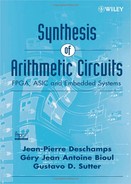8.4 OPERATIONS IN GF(pn)
If f is an irreducible polynomial then Zp[x]/f(x) is the Galois field GF(pn), so that every nonzero polynomial a(x) has a multiplicative inverse a−1(x). Given two polynomials
![]()
a variant of the extended Euclidean algorithm (Chapter 2, Section 2.1.2) allows the expression of the greatest common divider of f and a in the form
![]()
In particular, if gcd(f, a) = 1 then a−1(x) = b(x) mod f.
The following formal algorithm, in which degree(a) returns the degree of a and swap(a, b) interchanges a and b, computes z(x) = a−1(x).
Example 8.7
![]()
As p = 2, Algorithm 8.23 can be simplified; in particular, u(m) = υ−1(t) = υ(0) = 1.
Compute a−1(x):

![]()
In order to execute Algorithm 8.23, the following procedures must be defined:
- the procedure
procedure degree (a: in polynomial; deg: out natural);
computes the degree deg of a;
- the procedure
procedure invert (a: in coefficient; p: in module; b: out coefficient);
computes a−1 mod p; Algorithm 8.16 could be used;
- the procedure by_coefficient has already been defined;
- the procedure
procedure add (a, b: in polynomial; p: in module; c: out polynomial);
computes the sum of two polynomials; Algorithm 8.17 could be used;
- the procedure
procedure sub (a, b: in polynomial; p: in module; c: out polynomial);
computes the difference of two polynomials; Algorithm 8.18 could be used;
- the procedure
procedure shift (a: in polynomial; k: in natural; c: out polynomial);
computes c(x) = a(x).xk; it is equivalent to a k-position right-shift of the coefficients of a, with the k lower-degree coefficients set to 0.
The following algorithm is deduced from Algorithm 8.23 and from the previous procedure definitions (zero and one stand for the polynomials 0 and 1, respectively):
Algorithm 8.24 Inversion in GF(pn)
A different method, based on a modification of the Itoh–Tsujii algorithm ([ITO1988]), can be used if f(x) is a binomial ([WOO2000], [BAI2001]). First observe that if r = 1 + p + p2 + … + pn−1, then (Chapter 2, Section 2.2.4) (a(x))r is an element of Zp (a 0-degree polynomial). As
![]()
the problem is reduced to the computation of exponential functions in GF(pn) and to the inversion in GF(p).
The following formal algorithm computes z(x) = a−1(x).
Algorithm 8.25
In order to execute the preceding algorithm the following procedures must be defined:
- the procedure
procedure multiply (a, b, f: in polynomial; p: in module; z: out polynomial);
computes the product of a by b modulo f; Algorithm 8.20, 8.21, or 8.22 could be used;
- the procedures by_coefficient and invert have already been defined;
- the procedure
procedure exponentiation (a, f: in polynomial; p: in module; i: in natural; b: out polynomial);
computes ar(i) modulo f, where r(i) = pi.
It remains to generate the preceding procedure. First recall (Chapter 2, Section 2.2.5) that if α, β, …, γ are elements of GF(pn), then
More generally, if r(i) = pi, then
![]()
Observe also that, given a coefficient ak (an element of Zp), then
![]()
and, more generally,
From (8.17) and (8.18) the following relation is deduced:
![]()
Assume now that f is a binomial
![]()
and that n divides p − 1 (p mod n = 1), so that
![]()
Then
![]()
The values of
can be computed in advance (an algorithm for computing fki is given in Appendix 8.1), so that
The corresponding exponentiation procedure is the following:
procedure exponentiation (a, f: in polynomial; p: in module; i: in natural; b: out polynomial) is begin b(0):=a(0); for k in 1..n−1 loop modular_product (f(k,i), a(k), p, b(k)); end loop; end procedure;
The complete inversion algorithm is deduced from Algorithm 8.25.
Algorithm 8.26 Inversion, Second Version
In order to reduce the number of calls to the exponentiation procedure the following property can be used.
Property 8.1 If s = 1 + p + p2 + … + pk and t = 1 + p + p2 + … + pl, where k is odd and l = (k − 1)/2, then
![]()
where u = pk−l.
Proof
![]()
where
![]()
so that
![]()
If k+1 is a power of 2, that is, k = 2m − 1, then l = 2m−1 − 1, and the same decomposition can be recursively applied. The following algorithm computes z(x) = (a(x))s, where s = 1 + p + p2 + · · · + pk with k = 2m − 1.
Algorithm 8.27
b(0):=a; for j in 0..m−1 loop exponentiation (b(2*j), f, p, 2**j, b(2*j+1)); multiply (b(2*j), b(2*j+1), f, p, b(2*(j+1))); end loop; z:=b(2*m);
Example 8.8 k = 7, m = 3; in the following computation scheme r(i) stands for pi, so that r(i).r(j) = r(i + j).

Assume now that n−1 is a power of 2, that is,
Then
![]()
and
![]()
The preceding algorithm can be used for computing
![]()
It remains to compute
![]()
and
![]()
The complete inversion algorithm, when
is the following.
Algorithm 8.28 Inversion, Third Version
Observe that the main iteration is executed m times instead of n − 1 = 2m times as in Algorithm 8.26.
Example 8.9 If p = 239 and f(x) = x17 − 2, then Algorithm 828 can be applied:
![]()
the coefficients fki can be computed with Algorithm A 8.1.
Another example is the binomial x6−2 with
![]()
As n − 1 is not a power of 2, Algorithm 8.28 must be slightly modified.
